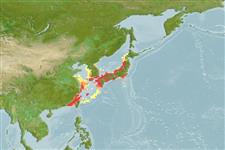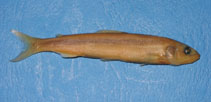Plecoglossus altivelis (Temminck & Schlegel, 1846)
Ayu sweetfish
Ajouter votre observation dans Fish Watcher
| Native range | All suitable habitat | Point map | Year 2050 |

|
| This map was computer-generated and has not yet been reviewed. |
| Plecoglossus altivelis AquaMaps Data sources: GBIF OBIS |
Envoyez vos Photos et vidéos
Pictures | Stamps, coins, misc. | Images GooglePlecoglossus altivelis
Picture by Islam, Md. S.
Pictures | Stamps, coins, misc. | Images GooglePlecoglossus altivelis
Picture by Islam, Md. S.
Japan country information
Common names:
Ayu, Koayu, Ryukyu-ayu
Occurrence: native
Salinity: freshwater
Abundance: abundant (always seen in some numbers) | Ref: Pastene, L.A., K. Numachi and K. Tsukamoto, 1991
Importance: highly commercial | Ref:
Aquaculture: commercial | Ref:
Regulations: | Ref:
Uses: gamefish: yes;
Comments: Occurs in western Hokkaido southward (Ref. 559, 11230). Found in Hokkaido's Ishikari river and the southern tributaries and river mouths (Ref. 12218); Nansei-shoto (Ref. 34989); Futatsukawa Creek, Fukuoka Prefecture (Ref. 37350); and Himi region from a habitat study conducted in Toyama Bay (Ref. 58909). Highly esteemed food and game fish. Cultured throughout western Japan in sea cages. Recorded as having been or being farmed in rice fields (Ref. 119549). Category in the 2005 Red Data Book of Shiga Prefecture: important distribution (Ref. 79825). Also Ref. 45563, 96271.
National Checklist:
Country Information: https://www.cia.gov/library/publications/resources/the-world-factbook/geos/ja.html
National Fisheries Authority: http://www.maff.go.jp/eindex.html
Occurrences: Occurrences Point map
Main Ref: Masuda, H., K. Amaoka, C. Araga, T. Uyeno and T. Yoshino, 1984
National Database:
Occurrence: native
Salinity: freshwater
Abundance: abundant (always seen in some numbers) | Ref: Pastene, L.A., K. Numachi and K. Tsukamoto, 1991
Importance: highly commercial | Ref:
Aquaculture: commercial | Ref:
Regulations: | Ref:
Uses: gamefish: yes;
Comments: Occurs in western Hokkaido southward (Ref. 559, 11230). Found in Hokkaido's Ishikari river and the southern tributaries and river mouths (Ref. 12218); Nansei-shoto (Ref. 34989); Futatsukawa Creek, Fukuoka Prefecture (Ref. 37350); and Himi region from a habitat study conducted in Toyama Bay (Ref. 58909). Highly esteemed food and game fish. Cultured throughout western Japan in sea cages. Recorded as having been or being farmed in rice fields (Ref. 119549). Category in the 2005 Red Data Book of Shiga Prefecture: important distribution (Ref. 79825). Also Ref. 45563, 96271.
National Checklist:
Country Information: https://www.cia.gov/library/publications/resources/the-world-factbook/geos/ja.html
National Fisheries Authority: http://www.maff.go.jp/eindex.html
Occurrences: Occurrences Point map
Main Ref: Masuda, H., K. Amaoka, C. Araga, T. Uyeno and T. Yoshino, 1984
National Database:
Common names from other countries
Classification / Names Noms communs | Synonymes | Catalog of Fishes(Genre, Espèce) | ITIS | CoL | WoRMS | Cloffa
> Osmeriformes (Freshwater smelts) > Plecoglossidae (Ayu fish)
Etymology: Plecoglossus: Greek, pleko, plekein = to fold + Greek, glossa = tongue (Ref. 45335).
More on authors: Temminck & Schlegel.
Etymology: Plecoglossus: Greek, pleko, plekein = to fold + Greek, glossa = tongue (Ref. 45335).
More on authors: Temminck & Schlegel.
Issue
All subspecies of Plecoglossus altivelis (Temminck & Schlegel, 1846) are synonymised under the species in Eschmeyer (CofF ver. Jul. 2010: Ref. 84883). Please send references, or more studies are needed.
Environment: milieu / climate zone / depth range / distribution range Écologie
marin; eau douce; saumâtre démersal; amphidrome (Ref. 51243); profondeur 10 - ? m. Subtropical; 44°N - 23°N
Distribution Pays | Zones FAO | Écosystèmes | Occurrences | Point map | Introductions | Faunafri
Northwest Pacific: western Hokkaido in Japan southward to the Korean Peninsula, Taiwan and China.
Length at first maturity / Taille / Poids / Âge
Maturity: Lm 27.5, range 30 - 40 cm
Max length : 70.0 cm TL mâle / non sexé; (Ref. 12218); common length : 15.0 cm SL mâle / non sexé; (Ref. 35840); âge max. reporté: 3.00 années (Ref. 12218)
Max length : 70.0 cm TL mâle / non sexé; (Ref. 12218); common length : 15.0 cm SL mâle / non sexé; (Ref. 35840); âge max. reporté: 3.00 années (Ref. 12218)
Description synthétique Clés d'identification | Morphologie | Morphométrie
Épines dorsales (Total) : 0; Rayons mous dorsaux (Total) : 10 - 11; Rayons mous anaux: 14 - 15; Vertèbres: 60 - 63. Pyloric caeca 350-400.
Typical amphidromous fish; appears in near shore from late autumn to spring (Ref. 11230). Found in lakes and rivers, preferring clean river water and can be found the entire river long, from the head to the mouth (Ref. 12218). Ascends the river during March when the temperature is around 10°C (Ref. 12218). Adults spawn in the spring, in the lower reaches of rivers. After spawning, some adults die while others return to the sea. Larvae enter the sea immediately after hatching and remain there during winter, feeding on plankton. In springtime, the young (5-7 cm TL) move upstream to the middle reaches of rivers to feed on algae. Fish (about 6-9 cm) start schooling at the river mouth and are insectivores and eat algae
off small pebbles (Ref. 12218); this is assisted by small leaf-like teeth which are loosely attached to the jaw with two ligaments (Ref. 45181). Those that are ready to spawn (about 20 cm TL) move downstream to the lower reaches of the river. Spawning adults from the sea migrate upstream to the lower reaches as well. Some fish spawn two or three years in succession, others only once (Ref. 9987 & 559). River forms live usually only one year whereas lake forms can live two or three years (Ref. 12218). Reaches maturity at 30-40 cm (Ref. 12218). Highly esteemed food fish. Marketed fresh and consumed fresh, fried and broiled (Ref. 9987).
Life cycle and mating behavior Maturité | Reproduction | Frai | Œufs | Fécondité | Larves
During spawning some fish go up the river and some fish spawn on the river shoreline above pebbles. Spawns at night and excavates a 10cm (diameter or depth?) pit. Eggs are around 1 mm in size and adhere to the sand or pebbles for 14 to 20 days before hatching. This fish is semelparous and releases eggs many times over a short period each time releasing ~10,000 eggs. Sometimes females that want to spawn but cannot, save their strength, and go to a deep stagnant pool. These females wait until spring before going up the river with young fish. After hatching, the larvae are 6 mm and flow with the water current eating plankton. Juvenile fish will come again to the river in spring. These live in schools. When schools of Plecoglossus altivelis return to their river they guard their territory and eat food (Ref. 12218).
Reproductive mode varies between semelparity and iteroparity. Large females spawn once, while smaller females spawn twice during a two-week interval (Ref. 76896).
Référence principale
Upload your references | Références | Coordinateur | Collaborateurs
Masuda, H., K. Amaoka, C. Araga, T. Uyeno and T. Yoshino, 1984. The fishes of the Japanese Archipelago. Vol. 1. Tokai University Press, Tokyo, Japan. 437 p. (text). (Ref. 559)
Statut dans la liste rouge de l'IUCN (Ref. 130435: Version 2024-2)
Données manquantes (DD) ; Date assessed: 03 September 2010
Menace pour l'homme
Harmless
Utilisations par l'homme
Pêcheries: hautement commercial; Aquaculture: commercial; pêche sportive: oui
FAO(Aquaculture systems: production; pêcheries: production, Résumé espèce; publication : search) | FishSource | Sea Around Us
Plus d'informations
Trophic ecology
Éléments du régime alimentaire
Composition du régime alimentaire
Consommation alimentaire
Food rations
Prédateurs
Éléments du régime alimentaire
Composition du régime alimentaire
Consommation alimentaire
Food rations
Prédateurs
Population dynamics
Paramètres de croissance
Max. ages / sizes
Length-weight rel.
Length-length rel.
Fréquences de longueurs
Mass conversion
Recrutement
Abondance
Paramètres de croissance
Max. ages / sizes
Length-weight rel.
Length-length rel.
Fréquences de longueurs
Mass conversion
Recrutement
Abondance
Life cycle
Reproduction
Maturité
Fécondité
Frai
Spawning aggregations
Œufs
Développement de l'œuf
Larves
Dynamique des populations larvaires
Reproduction
Maturité
Fécondité
Frai
Spawning aggregations
Œufs
Développement de l'œuf
Larves
Dynamique des populations larvaires
Anatomy
Surface branchiale
Brain
Otolith
Surface branchiale
Brain
Otolith
Physiology
Body composition
Nutrients
Consommation d'oxygène
Type de nage
Vitesse de nage
Visual pigments
Fish sound
Diseases & Parasites
Toxicity (LC50s)
Body composition
Nutrients
Consommation d'oxygène
Type de nage
Vitesse de nage
Visual pigments
Fish sound
Diseases & Parasites
Toxicity (LC50s)
Human related
Aquaculture systems
Profils d'aquaculture
Souches
Ciguatera cases
Stamps, coins, misc.
Aquaculture systems
Profils d'aquaculture
Souches
Ciguatera cases
Stamps, coins, misc.
Outils
E-book | Guide de terrain | Générateur de fréquences de longueur | Outil de dynamique de population | Carte par point | Classification Tree
| Catch-MSY |
Articles particuliers
Télécharger en XML
Sources Internet
Alien/Invasive Species database | Aquatic Commons | BHL | Cloffa | BOLDSystems | Websites from users | FishWatcher | CISTI | Catalog of Fishes(Genre, Espèce) | DiscoverLife | ECOTOX | Faunafri | Fishtrace | GenBank(génôme, nucléotide) | GloBI | GOBASE | | Google Books | Google Scholar | Google | IGFA World Record | MitoFish | Bases de données nationales | Otolith Atlas of Taiwan Fishes | PubMed | Reef Life Survey | Scirus | SeaLifeBase | Arbre de Vie | Wikipedia(aller à, chercher) | World Records Freshwater Fishing | Zoological Record
Estimates based on models
Preferred temperature (Ref. 115969): 13 - 22.6, mean 19.7 (based on 42 cells).
Phylogenetic diversity index (Ref. 82804): PD50 = 1.5000 [Uniqueness, from 0.5 = low to 2.0 = high].
Bayesian length-weight: a=0.00427 (0.00166 - 0.01096), b=3.06 (2.83 - 3.29), in cm Total Length, based on LWR estimates for this (Sub)family-body shape (Ref. 93245).
Niveau trophique (Ref. 69278): 2.8 ±0.16 se; based on food items.
Résilience (Ref. 120179): Haut, temps minimum de doublement de population inférieur à 15 mois (tm=1; tmax=3; Fec=50,000-100,000).
Fishing Vulnerability (Ref. 59153): Moderate to high vulnerability (48 of 100).




